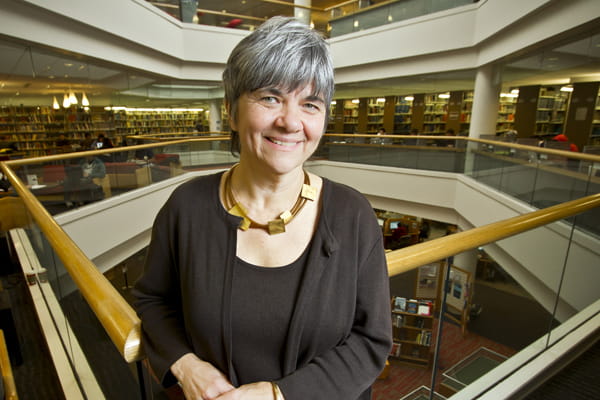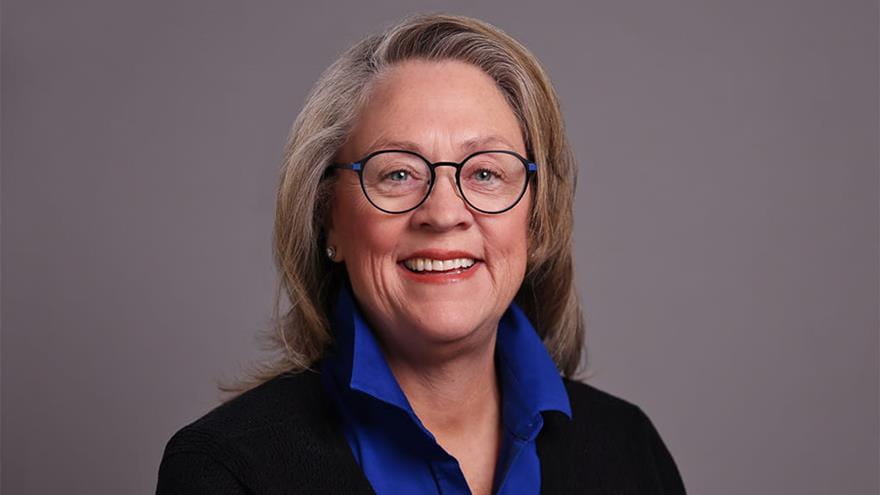Q&A with Danuta Nitecki: The Future of Libraries

When Danuta Nitecki came to Drexel in 2010 as dean of libraries and professor of information science in the iSchool, College of Information, Science and Technology, it wasn’t her first involvement with the University. The first time she stepped foot on Drexel’s campus, she was a young graduate student in the school’s intense one-year master of library science program. Having already worked on a master’s in art history, she thought a library degree would turn her love of art into a viable career path as an art librarian.
Her plans changed.
While she continued to pursue art-related positions, she signed up for an interview for a library administration manager position at the University of Tennessee Knoxville as interview practice. The meeting with the recruiting library director resulted in an offer that she accepted and moved south. Fairly quickly, she fell in love with the study and application of information science in an academic library.
“Soon after, I got a call from the Philadelphia Museum of Art,” she said, “with an invitation to consider my original dream job working as an art librarian. But I’d come to a fork in the road, and there was no turning back. I never became an art librarian. What really interested me was studying what makes libraries, libraries.”
Now she’s putting that early curiosity and rich career of evolving theory into practice with the challenge to redefine the academic library at Drexel.
Drexel Quarterly asked Nitecki to reflect on her first three years as dean and to look ahead to the next few years.
What was it like coming back to Drexel, where you began your career?
Drexel’s a very dynamic, vital place and it’s exciting to be here. But I didn’t expect how special it would feel to come back to my academic roots. I didn’t plan for it, but once I was here, I felt what a nice opportunity it was to return to my professional foundation. It’s a way of thanking the University for a rewarding and exciting career.
What’s the biggest issue you face now that you’re here?
The challenge is to redefine the University library for the 21st century. It will certainly change a lot in the next five or 10 years, and that is not unique to Drexel. It’s a wider concern professionally. We need to address the very core value of a library. Some university leaders have questioned whether there is a need for an academic library. So how do you refine what it offers to show the value to the institution?
Clearly the way that information is provided, organized and delivered has dramatically changed with the Internet. With that has come a change in information-seeking behavior. Students today need to be self-directed, independent learners, and one of the major reasons for higher education is to develop those skills.
This is the Information Age, so we need to prepare students to be productive leaders in our workforce and society by being able to navigate this information landscape—how to identify relevant information, retrieve it, how to know what’s useful, and how to use it ethically. And that’s what an academic library is about.
What were the first issues you tackled when you showed up three years ago?
For the first two years, we explored how the library is part of the learning enterprise. Librarians are educators, and we work with the faculty to help coach and guide the students to be self-directed learners.
Then last summer we conducted a very interesting exercise using a planning process called Future Search. For 2 ½ days, we brought together nearly 60 people—students, faculty, external friends and funders, administrative support, information professionals—to focus on the library’s future to advance the University’s mission. This is a protocol used internationally to bring stakeholders from various interests together to look for common ground, think about the future, and propose actual plans, programs and activities.
What plans came out of that exercise?
Our purpose was to look into the future to align our five-year plan with the University’s. We identified four primary strategic goals. First, ensure access to information. Second, build learning environments in both physical and cyber spaces. Third, strengthen Drexel’s connection to scholarship. And finally, model an organization that can be customer-centric, evidence-based and responsive.
The W.W. Hagerty Library is about to undergo renovation. Can you explain your goals?
Libraries bridge the space between people and information, but what does it mean to have a library as a place? What is the physical space? What features does a learning environment need? What collections, what services? Not just in physical space but in cyber space as well.
At Drexel we are challenged because the Hagerty Library is one of the most heavily used spaces on campus. The place is packed from the first day of each term. The students are here looking for an environment where they can concentrate. On occasion, they take a break and look for a place to have coffee and meet with other students.
We’ve been doing a lot of envisioning and thinking about how to renovate the library as a learning environment. I’ve enjoyed creating new models, environments and configurations. For example, we have a mobile librarian who takes a laptop and sits in a student lounge to meet with students who are working in her area of expertise. They know when she’s there and can get help.
It’s interesting—two contradictory trends. The library as a place is more important, and yet information is digital.
Sometimes people say if you have all the information you need in the palm of your hand, why do you need a space at all? But students are still looking for that kind of concentrated self-learning environment on campus. We also support students and professors for distance learning, and that’s a different challenge.
The information itself now is quite different. The library here made a good decision years ago to focus its resources on building electronic access. More than 90 percent of our collection budget is spent on licensing and contracting information access rather than building a traditional library with lots of print books.
Moving forward, we’re working with others on campus on the exciting issue of how to manage the information that’s created by our researchers, whether it’s published in the form of a journal article or a DVD or a book. Information has a container, but what about the raw data behind it? The points on a map, messages on a blog, and computational output in chemistry—how do we organize and provide access to that?
Some of the challenge involves being able to preserve our digital collections. We’re concentrating on capturing Drexel’s memory through our archives as part of our operation. The way science is progressing now in all fields, there needs to be a repository of all these data that is organized and accessible so that it can be used again. This is the next venture for the library here at Drexel. What role do we have to organize and preserve data sets, and help students and researchers understand the tools to access, interpret and use them in an ethical manner?
Each year, academic journals are more expensive. And with licensing, unlike buying a book, you pay every year, instead of paying once and then you own it forever. Is that a challenge, budget-wise?
Of course. The cost of information as a commodity is rising. We have specialists in the library who manage that element and make choices about needs for teaching and research. We’re here to provide access to authoritative information, and our collection, whether print or electronic, is a product of making decisions and selections. There’s no library in the world that can have everything. Not even the Library of Congress, big as it is, can have it all.
In terms of the budget, we report to Provost Mark Greenberg, who has generously supported the libraries. But the University doesn’t have an endless supply of money, and we still have to make choices. We have to meet the needs of a broad community, not just individual departments. One way we offer access is through collaborative agreements. Our faculty and researchers can use the University of Pennsylvania library. We have a very active interlibrary loan service so we can borrow or acquire specific items that are not locally available.
How do you collaborate more closely with researchers? How will faculty and staff be able to work with you in the future?
Building connections is a major strategic direction in the libraries. This academic environment isn’t different from many other universities. People work within their discipline, and we’re here to serve all of them. We try to break through silos. We try to introduce people to new areas of information, whether it’s a freshman learning about different tools or an advanced researcher stretching into unfamiliar areas. We work with faculty to develop curriculum around information-based literacy skills. It’s one of Drexel’s learning priorities, and one way we can contribute to Drexel’s educational mission.
To answer the specific challenge of using data, Deborah Crawford, vice provost for research, has a committee looking at how the University addresses the needs of computational research and resulting “big data.” As a member of the group, I am looking at ways we could collaborate.
We are open to any kind of ideas from faculty. We’ve worked with some faculty on their grants. We’ve helped develop instructional support for their curriculum. We have a number of librarians who are specialists as liaisons to each of the schools and colleges. These people have not only library training but often experience and advanced degrees as subject specialists. They understand what the researchers do and work as partners.
As an institution Drexel has a very strong service orientation and grounding in the instructional side. As Drexel’s strategic direction becomes more focused on research and transformation technologies, we are beginning to be more involved in the research end.
We work to make life a little simpler for administrators, faculty and students. Drexel Libraries has an incredible staff—hard-working and service-oriented— and we’re trying to leverage those qualities to be even a stronger organization for the University.
In This Article
Drexel News is produced by
University Marketing and Communications.
